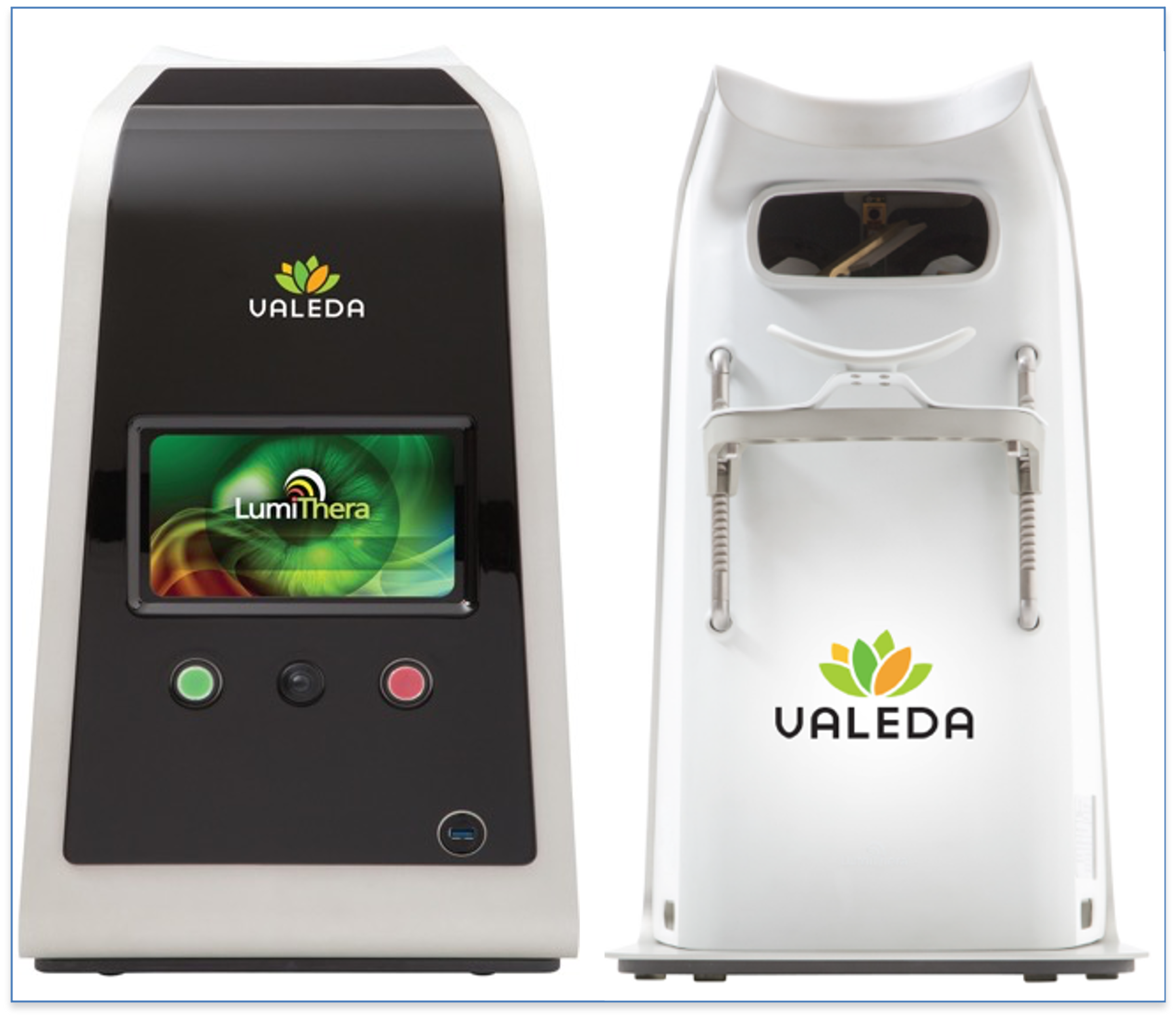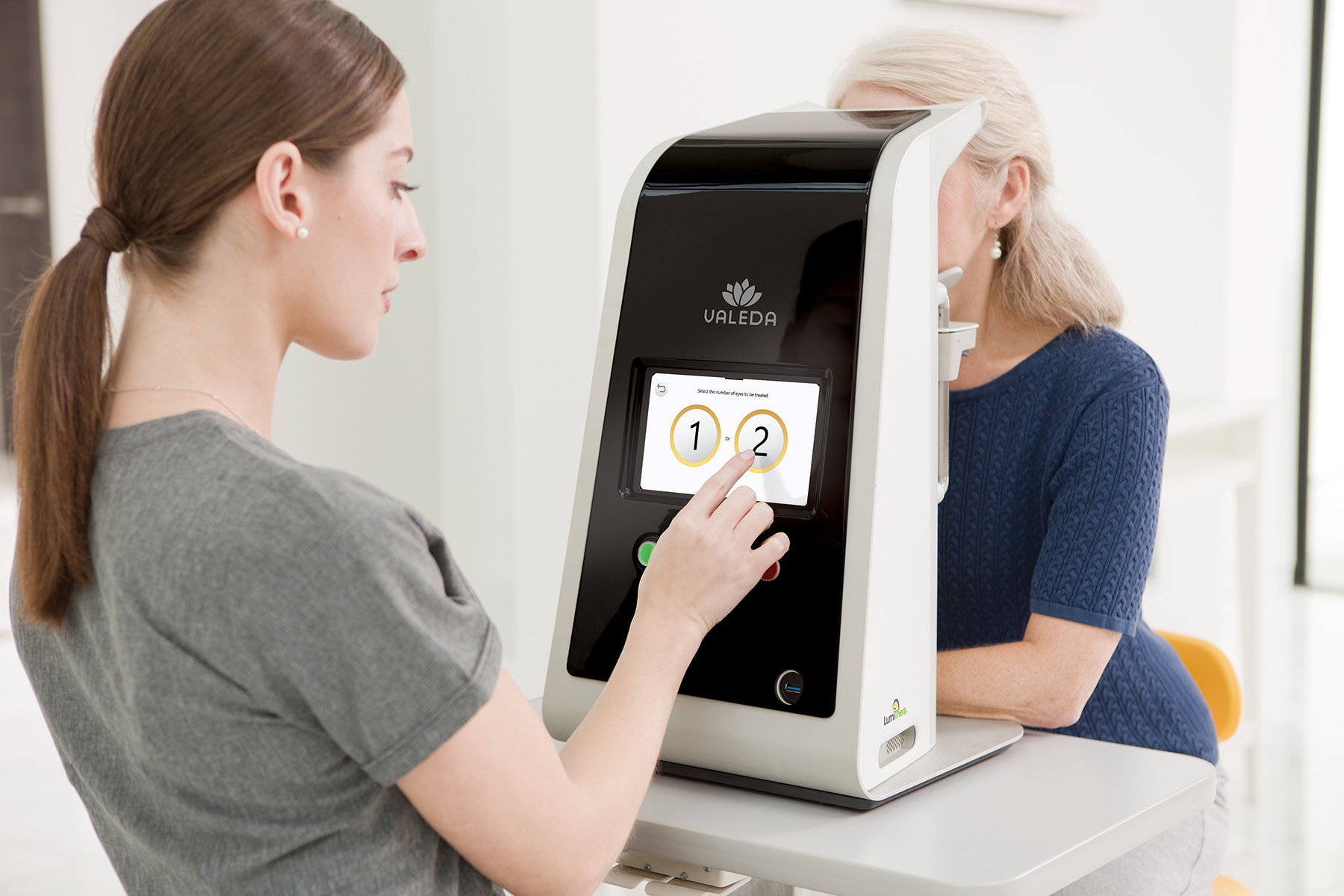VALEDA Light Delivery System for Dry Age-Related Macular Degeneration (AMD) in Indianapolis
What is VALEDA Light Delivery System?

Valeda Light Delivery System is the first and only treatment for Dry Age-Related Macular Degeneration (AMD)
to improve vision. While there is no cure for dry AMD, early treatment is important. Valeda uses photobiomodulation (PBM), specific wavelengths of light, to stimulate energy production within the cells resulting in improved cellular health. Treatment with Valeda can improve your vision now
and in the future.
What Is Dry Age-Related Macular Degeneration (AMD)?
Dry age-related macular degeneration (dry AMD) is an eye condition and a leading cause of vision loss in older adults. It affects the macula, the central part of the retina responsible for sharp, straight-ahead vision used for activities like reading and driving.
There are three main stages to dry age-related macular degeneration.
Stage 1: Early AMD
Small yellow deposits called drusen form under the retina. As they accumulate, they can interfere with the function of the retina and lead to thinning and atrophy of macular tissue. There is typically no vision loss.
Stage 2: Intermediate AMD
Larger drusen and/or pigment changes in the retina; some vision changes may be noticeable.
Stage 3: Advanced AMD
Advanced dry AMD can cause retinal cells to deteriorate and may result in cellular death, leading to geographic atrophy and permanent vision loss.
The video below will answer many of the frequently asked questions about dry AMD.
Treating Dry AMD with Valeda Light Delivery System

Valeda delivers a non-invasive, multiwavelength, light-based therapy that utilizes photobiomodulation (PBM) to treat dry age-related macular degeneration (AMD) patients to improve vision.
Valeda’s targeted treatment addresses mitochondrial dysfunction in the retina, a key component of dry age-related macular degeneration (AMD) , to improve visual acuity and enhance patient outcomes.
Is a Valeda Light Delivery System for Dry AMD Treatment Right For Me?
Please call (317) 844-5530 or click on the button below to schedule an appointment to meet with one of our eye specialists so we can determine if Valeda is right for you.
Valeda Light Delivery System Frequently Asked Questions (FAQs)
- Who is suitable for the VALEDA treatment?
VALEDA is indicated for use in the treatment of dry age-related macular degeneration (AMD) patients with vision impairment. Those individuals receiving treatment should have a doctor diagnosis of Dry AMD. The stage of Dry AMD may impact the benefits of the treatment.
Your doctor will discuss your diagnosis and treatment plan with you.
- Who is NOT suitable for the VALEDA treatment?
As a precaution, patients have not been tested and should not be treated with VALEDA if they have any known reactions to light exposure, or if they have a history of light-activated central nervous system disorders (e.g., epilepsy, migraine).
In addition, patients should not receive treatment within 30 days of using any photosensitizing medications (e.g., topicals, injectables) before consulting with their physician.
- What’s involved with the VALEDA treatment? Do I need any special preparation?
If you wear glasses or contact lenses, you will be asked to remove them prior to receiving treatment. Your eyes will not be dilated for the VALEDA treatment. You will be seated comfortably at the VALEDA Light Delivery System.
The person administering the treatment will guide you through each step of the treatment which takes less than 5 minutes. Treatment for both eyes will take less than 10 minutes. Clinical trials have shown benefits in visual function following treatment 3 times a week for 3-4 weeks. This is the recommended treatment protocol for patients with Dry AMD.
In a recent clinical study, patients received no more than 3 treatments a week and no more than one treatment in a 24 hour period. If you miss a treatment, it is recommended to make up the session within the 3-4 week treatment series period.
- What are clinical benefits of the VALEDA treatment?
Treatment with VALEDA improves benefits in overall visual function including improvement in vision when scored on the eyechart and improved detailed vision.
Photographic imaging also shows improvement in scans of the eye when assessed for drusen (protein deposits that are observed in the diseased eye).
- What are the potential side effects of the VALEDA treatment?
Photobiomodulation (PBM) is a low level light based therapy that helps cells improve their function. PBM has been used in many different diseases and disorders for decades with a positive safety profile.
In clinical trials in dry AMD patients, the use of light therapy has also been shown to be safe. VALEDA is designed to be eye safe. There have been no treatment-related side effects noted in previous studies
with the VALEDA.
- What can I expect during and after the VALEDA treatment?
It is well known that looking at bright light can produce an afterimage. Another name for this is photobleaching, where the cells that “see” that specific color become fatigued.
For example, if you look at a red light, those colors may fade after treatment and you will see more of the opposite color (i.e., green). This phenomenon may be seen immediately following the treatment and will recover in a couple of minutes.
You will be able to partake in normal activities following the treatment.
- What if I have Cataracts?

